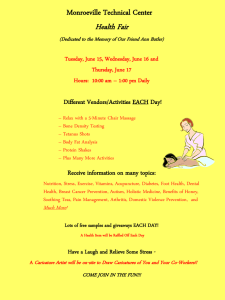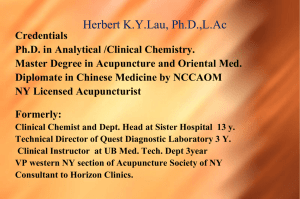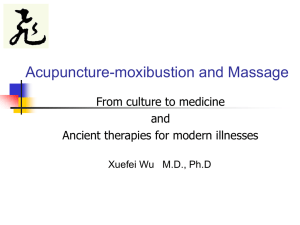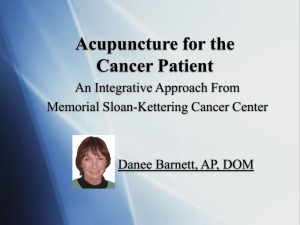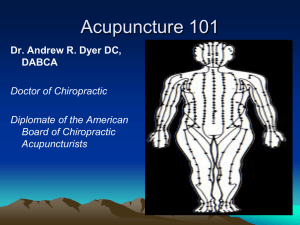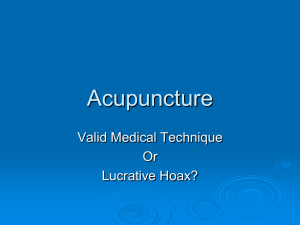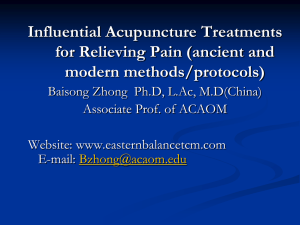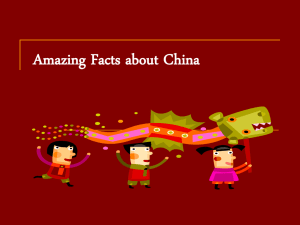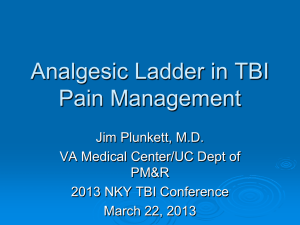Acupuncture Introduction and Overview
advertisement
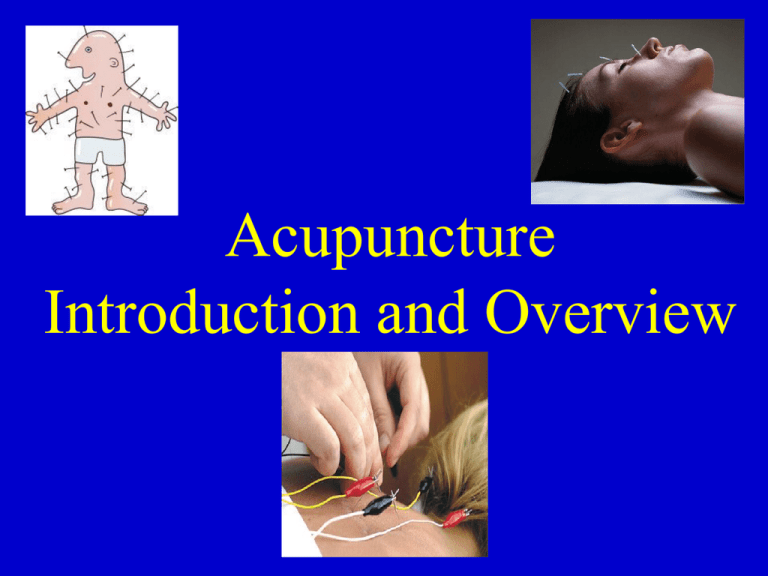
Acupuncture Introduction and Overview • • • • • • • Definition U.S. History Evidence of Efficacy Mechanism of Action Types of Acupuncture Practical Tips Coding • • • • • 3.1 million have used in U.S Literally means 'needle piercing’ Traditional acupuncture regulates the flow of Qi (vital energy) There are many types of Qi Qi is considered one of the human body's fundamental substances and helps to maintain normal activities • Qi permeates all parts of the body, and flows along organized pathways known as acupuncture channels, or meridians. • Traditional Chinese Medicine practitioners believe that a balanced flow of Qi throughout the system is required for good health, and imbalances can be corrected by acupuncture stimulation • Thus, a state of good health is determined by the dynamic balance between opposing yin-yang forces Acupuncture in the U.S. • Documented evidence of use in 1826-Franklin Bache, a Philadelphia physician and grandson to Benjamin Franklin, published an article of its use • Sir William Osler also endorsed acupuncture as an effective treatment for lumbago and sciatica in The Principles and Practice of Medicine • Referenced in an Civil War surgeon's manual Modern U.S. History • 1971 James Reston wrote a front-page article for the New York Times describing how his postoperative pain from an emergency appendectomy was relieved by acupuncture while traveling in Beijing • Prompted a group of US physicians to observe practice in China and publish an article in Journal of the American Medical Association • During Historic visit to China in 1972, President Nixon and his personal physician witnessed several surgeries using acupuncture-assisted anesthesia • Most well designed studies show mixed results • Placebo response high- If positive expectation then greater pain relief Fair Evidence for: • Back pain • Joint pain • Neck pain • Headache • Cancer Pain • N/V from Pregnancy and Cancer Acupuncture Point • Nerve fibers woven among blood and lymph vessels leading to superficial levels on the dermis • Epidermis thins at the acupuncture point and has a corresponding modification of collagen fibers *71% correlation between trigger points and acupuncture points* Mechanism of Action • Mechanism of action is through conduction of bioelectromagnetic signals • Activates opioid systems, and autonomic and central nervous systems, causing the release of various neurotransmitters and neurohormones Note: Acupuncture analgesia can be completely blocked by Naloxone • • • • Mechanism of Action Needling an acupuncture point stimulates a bioelectric response Changes the electrical charge 2 Hz releases diencephalons act on anxiolytic μ receptors 2 to 15 Hz releases β-endorphin and met-enkephalin in the brain and dynorphin in the spinal cord -more effective in relieving deep and chronic pain • 100 Hz causes release of dynorphin alone • Something else is actually going on as analgesic effect is much longer than the half-life of endorphins Evidence of Efficacy • fMRI Evidence • Technetium-99m injected at acupuncture point shows diffusion along different pathways and rates than vascular and lymphatic channelscredence to meridian theory PRINCIPAL MERIDIANS P R I N C I P A L M E R I D I A N S • Needle – – – – Type Combination Depth Direction • Location • What is done to the needle – Left alone- dispersion – Manipulated and/or Stimulated • Manually- rate and duration • Electrically – Frequency – Duration • Heated – (Moxa Cigar/Heat lamp/etc) • Functional Point Acupuncture • Energy Moving Acupuncture – Principal Meridian – Curious Meridian – Tendon Muscular Meridian • • • • • Distinct Meridian Scalp Acupuncture Auricular Acupuncture Cupping Qua Sha (Scraping) Two Needle Technique • Great for trigger points or musculotendinous pain • Point of Maximal Tenderness- place 2 needles about 5-10 mm apart • Connect to Electrical Stimulator for 10-15 min at >10 Hz • Repeat as needed Scalp Acupuncture -Good for general pain states -Used alone or as adjunct Semi-Permanent Needle Ear Acupuncture – same as scalp BFA-all purpose pain tx Coding(CPT) and Reimbursement • 97810: one or more needles, without electrical stimulation, initial 15 minutes -0.60 RVU • 97811: Each additional 15 minutes, with reinsertion of needles -0.50 RVU • 97813: one or more needles, with electrical stimulation, initial 15 minutes -0.65 RVU • 97814: Each additional 15 minutes with reinsertion of needles – 0.55 RVU Complications • Few complications have been reported • Serious adverse are infections and punctured organs • There are fewer adverse effects associated with acupuncture than with many standard drug treatments • At least 2 reports of Pneumothorax QUESTIONS???? www.lhasaoms.com Acupuncture Supplies
